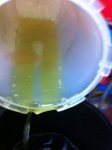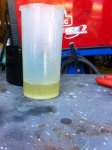- 3,657
- 29
- 48
- Location
- Dallas, Texas
The important part first, the story is after.
DOT 3, 4, and 5.1 can be mixed if necessary, according to the instructions on the cans. The temperature range is higher as it progresses from DOT 3 to 4 to 5.1
DOT 5 and DOT 5.1 are not the same.
DOT 5 is a silicone based fluid, and DOT 3, 4, and 5.1 are glycol? based.
don't guess.... this is how to check:-
Essentially, there are two types. The first one is regular auto brake fluid. The second type is Silicone-based brake fluid.
You can not mix the two types of fluid (well, you can, but you will end up with a jelly-like mess).
You need to find out which you have already in the system. Here's how:-
1. Get a dropper (an eye or ear-dropper) and withdraw some fluid from the master cylinder.
2. Put it into a glass jar and then add some clean water to the fluid.
3. Now put the lid on the jar and shake it well.
4. Let it stand for a few minutes.
5. If the water and the fluid have mixed thoroughly and can not be separately identified, then you have regular auto brake fluid.
6. However, if the water and the fluid have not mixed, or have formed blobs or layers, then the fluid is Silicone.
That's all there is to it. Lots of people think that you can recognise which is which by looking at the colour of the fluid, or by its odor. Don't risk it. Use the test outlined above. It's already been said that DOT 5 is not always purple, or that it can change color after time to a yellow that looks like DOT 3.
=====
Being faced with this today, I dug the above info up from the mil veh list. It's worth posting here since a mistake can be costly and dangerous. My DOT 5 had indeed turned yellow, or maybe it was the original military fluid, which has been reported to be light-colored.
The M35's brake pedal had been requiring much more travel before engaging the brakes. Not finding any leaks but having put alot of miles on the truck, I checked the master cylinder and found it nearly empty! This was a disaster waiting to happen. The brakes had apparently worked just fine until the master was almost completely out of fluid and then there was little warning before the brake pedal gained about 3" extra travel.. The truck still stopped OK when hot but it didn't 'feel' right. When cold, the brakes had become very mushy. What was going on is that the fluid level had gotten low enough to where air was entering the master cylinder itself, creating the mushy feel. Inspection revealed that the resivoir was about dry. As I poured the new fluid in, I could hear air bubbling up from places air should not have been. It took almost the entire 12oz can. There was some concern that after refilling the master cylinder resivoir that the system would have to be bled. I was fortunate in that after gently and slowly working the pedal a number of times, the air trapped in the cylinder bubbled up and I have a nice hard pedal again. It may still need to be bled on general principles, first needs a road test.
The moral of the story I suppose is to check the fluid periodically, no matter what a pain in the butt it is, even if there seems to be nothing wrong. Several times I almost cursed the guy that decided to put the master cylinder right under a cab frame mount.
The vent line came off with a 3/8" line wrench and the resivoir cap came off with a 11/16 wrench. The resivoir cap 'nut' was square so an open end wrench fit best.
DOT 3, 4, and 5.1 can be mixed if necessary, according to the instructions on the cans. The temperature range is higher as it progresses from DOT 3 to 4 to 5.1
DOT 5 and DOT 5.1 are not the same.
DOT 5 is a silicone based fluid, and DOT 3, 4, and 5.1 are glycol? based.
don't guess.... this is how to check:-
Essentially, there are two types. The first one is regular auto brake fluid. The second type is Silicone-based brake fluid.
You can not mix the two types of fluid (well, you can, but you will end up with a jelly-like mess).
You need to find out which you have already in the system. Here's how:-
1. Get a dropper (an eye or ear-dropper) and withdraw some fluid from the master cylinder.
2. Put it into a glass jar and then add some clean water to the fluid.
3. Now put the lid on the jar and shake it well.
4. Let it stand for a few minutes.
5. If the water and the fluid have mixed thoroughly and can not be separately identified, then you have regular auto brake fluid.
6. However, if the water and the fluid have not mixed, or have formed blobs or layers, then the fluid is Silicone.
That's all there is to it. Lots of people think that you can recognise which is which by looking at the colour of the fluid, or by its odor. Don't risk it. Use the test outlined above. It's already been said that DOT 5 is not always purple, or that it can change color after time to a yellow that looks like DOT 3.
=====
Being faced with this today, I dug the above info up from the mil veh list. It's worth posting here since a mistake can be costly and dangerous. My DOT 5 had indeed turned yellow, or maybe it was the original military fluid, which has been reported to be light-colored.
The M35's brake pedal had been requiring much more travel before engaging the brakes. Not finding any leaks but having put alot of miles on the truck, I checked the master cylinder and found it nearly empty! This was a disaster waiting to happen. The brakes had apparently worked just fine until the master was almost completely out of fluid and then there was little warning before the brake pedal gained about 3" extra travel.. The truck still stopped OK when hot but it didn't 'feel' right. When cold, the brakes had become very mushy. What was going on is that the fluid level had gotten low enough to where air was entering the master cylinder itself, creating the mushy feel. Inspection revealed that the resivoir was about dry. As I poured the new fluid in, I could hear air bubbling up from places air should not have been. It took almost the entire 12oz can. There was some concern that after refilling the master cylinder resivoir that the system would have to be bled. I was fortunate in that after gently and slowly working the pedal a number of times, the air trapped in the cylinder bubbled up and I have a nice hard pedal again. It may still need to be bled on general principles, first needs a road test.
The moral of the story I suppose is to check the fluid periodically, no matter what a pain in the butt it is, even if there seems to be nothing wrong. Several times I almost cursed the guy that decided to put the master cylinder right under a cab frame mount.
The vent line came off with a 3/8" line wrench and the resivoir cap came off with a 11/16 wrench. The resivoir cap 'nut' was square so an open end wrench fit best.



